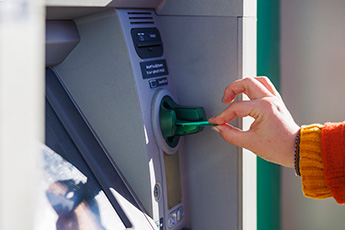Items include
- 1 Podcasts
- 270 BID Newsletters
technology
Podcasts

In this episode, we're joined by Kendra Ramirez, CEO of KR Digital Agency and an expert in Artificial Intelligence (AI), to explore the far-reaching impacts of AI across industries, focusing on how to harness the potential of generative AI in banking.

In this second article reviewing 2025 banking trends, we address challenges and opportunities CFIs have encountered over the past year and how they have responded to support their continued growth and resilience.

RegTech can help CFIs boost compliance, cut costs, and reduce risk. Recent advances are making it more accessible and cost-effective for CFIs to adopt these solutions. We provide a roadmap for implementation.

Bank Director’s 2025 Technology Survey reveals a mismatch between technology/AI investment and effective data usage, legacy integration, and ROI measurement. We explore the survey’s key findings and implications for CFIs.

Cloud computing is ubiquitous, but it comes with drawbacks. We discuss why some companies have begun to repatriate some of their operations and storage from the cloud to onsite facilities.

More than half of tech executives say the chip shortage should be over early next year; some say it has already waned. We review the microchip shortage’s impact on financial institutions and how quickly the changes are expected.

Emerging technologies and changing work arrangements are increasing the banking industry’s abilities to better serve disabled people — both customers and employees alike. We highlight new inclusive innovations within the industry that CFIs should consider taking advantage of.

Many CFIs have invested substantial time, energy, and capital in improving the banking experience they offer to retail customers. Unfortunately, they haven’t paid the same attention to the business banking experience, says a recent study. A full 68% of respondents thought the digital features of business banking were lagging behind those for retail customers. Here’s how your CFI can take another look at the experience you offer, from a different perspective.

CFIs say their top strategic goal is growing loans. They also say they plan to increase tech spending. Targeting more of that increased tech spending on products demanded by small businesses can help advance loan growth.

According to a recent report from McKinsey & Co., 71% of customers expect companies to personalize their interactions. Community Financial Institutions (CFIs) have traditionally delivered personalized experiences through their customer interactions and building strong relationships. But now, it’s vital to aggregate, integrate, and analyze customer data in ways that let CFIs anticipate and predict future needs.

It’s a common problem. Customers want personalized service, but are reluctant to share their personal data to power that. A smooth authentication process, as the first point of contact between a CFI and a customer, can help build the trust that customers need to forge a new or ongoing banking relationship, and offer CFIs access to their information.

Community financial institutions know their customers well. Yet, this is no time for complacency as competitors abound. Technology is an important tool in understanding your customers’ shifting needs. Here are three key areas to use technology to more effectively respond to your customers.

The FDIC’s technology lab, FDITECH, recently announced its launch of a tech sprint to provide the right tools for community financial institutions to engage with the unbanked. We give you an update on this project, along with the current costs for the unbanked and the opportunities for institutions that can connect with them.

As the economy opens up more and more, community financial institutions will be looking for ways to use their liquidity and boost SMB lending. We give you a few ways to do that: leverage automated processes, continue to offer SBA loans, boost construction lending (in the right markets), and create new lending niches.

Podcasts are smart marketing. They have a recall rate 4x higher than other digital channels and the number of US podcast listeners is expected to grow 16% YoY to over 106MM. If you want to start a podcast, the steps include planning a series, reviewing other podcasts, and finalizing your podcast format.

The majority of bankers these days are working on implementing technologies to keep their customers happy. We give you four mistakes to avoid when doing so.

AI decision-making systems can help community financial institutions to eliminate bias in credit decisions. We explain how to do it.

The move to increasingly high-speed networks with 5G is a potent change. We give you four areas in banking that will be affected.

Reopening businesses require new protocols -- and it looks like technology will play a major role in these efforts.

A large percentage of consumers are distrusting of the ability of organizations collecting their data to keep it secure. We provide some ways to reassure your customers.

Technology can be pretty amazing, but for community financial institutions, it can cause sleepless nights too. We have some suggestions to help.

Contactless payment has struggled in the US. But, it appears that is about to change.

HSBC and Goldman Sachs have invested in a fintech platform which allows banks to offer products from their rivals. This may sound counterintuitive, but could it help your bank and your customers?

Big data is supposed to give banks' customers exactly what they need at the time they need it. Although this hasn't exactly happened yet, we are making progress

Chatbots are becoming more sophisticated, and bank customers seem more willing to use them. Is now the time to start using chatbots at your bank?

Bankers everywhere want to modernize rapidly in order to meet their customers' expectations. To reach that goal, some are seeking fintech partners. What to consider if you find yourself ready for this partnership.

We explain how one bank is using smartwatches to decrease wait times and increase customer satisfaction.

Collections are a hassle for all banks for a host of reasons. Some banks are finding new ways to address this age-old issue.

Competition is growing as agricultural-focused fintech firms (agtech) are entering the market. We offer some tips to help.

Global digital payments volumes are expected to increase by nearly 11% through 2020. What community banks should know to guide their business customers on the technology and the providers.

As more people are using bank websites or mobile apps to open accounts or apply for other services, bankers need to continue to improve their web forms. We have some considerations to include.

A Deloitte study shows customers that can open new accounts easily and relatively quickly are more loyal. We provide the highlights for you.

Construction lending can be messy and complex. We provide some tips for streamlining.

Aite Group examined how much time commercial lenders devote to core responsibilities. We provide you with some of the results.

Some community banks are shifting from traditional ads to digital ads. Is it worth switching?

Do your small business customers want to use a remote deposit check service? A recent survey says they might.

Facebook emerges as a new competitor for banks as it partners with Clearbanc. What community banks should know.

AI-backed CRM systems offer major benefits, but they also involve risks. We outline the challenges of using AI for customer service and share training and security tips to minimize risks.

Access to users’ real-time geographic location information allows CFIs to boost security measures and improve relationships with younger customers. We discuss geolocation data strategies that could benefit your CFI.

Not all cyber threats are external. That’s why it’s imperative to periodically review which employees have access to which systems. We detail best practices of identity and access management.

As Bluetooth usage becomes more prevalent and scammers increasingly use it as a way to hack people’s devices, CFIs should pay closer attention to related security measures.

Attacks on Domain Name Systems are rampant and can result in major problems. A compromised domain name can cause myriad headaches for both the company and its customers.

Is your password too easy to guess? We discuss recent findings about the most common passwords and provide tips on creating more complex passwords that you can still remember.

In this third part of our review of 2024, we look at the challenges and opportunities arising from continued digital adoption, the uptake in AI, and the increased threat of cyberattacks.

Text message one-time passcodes are increasingly vulnerable to interception. We discuss the concerns and the alternatives CFIs should consider to boost security.

By 2025, experts say that 75.4B IoT devices will be connected globally, which is more than double from 2021. This surge in connected devices increases the opportunities for cyber thieves to find vulnerabilities and cause havoc for entire business systems, including community financial institutions. Do you have updated endpoint security to stop them?

Our readers asked us about opening banking, cyber-attacks and AI in credit decisions. Today, we provide our insight.

Many banks use text message authentication, but thieves are finding ways to hack it. We provide an update along with tips to keep you and your customers safe.

The rate of voice fraud has risen more than 350% from 2013 to 2017 with no signs of abating. What can you do to protect your bank from this new threat?

Unlike traditional biometrics, such as a fingerprint, invisible biometrics use sensors or computer coding that are unknown to an individual. We provide you with the details of this new technology.

A recent FICO study shows 80% of consumers don't see the need for what they consider unnecessary security procedures. How to strike a balance between security and customer satisfaction.

A new report now predicts that in two short years, 1.9B bank customers will be using biometrics to perform a variety of functions. We give you a rundown of the latest in biometrics.

With the explosion of IoT devices comes increased cyber risk for banks. Guidance from the government has been released to keep organizations safe. We have the main takeaways.

Celent finds IT spending by US banks has risen by more than $10B in the past 5Ys. We help you avoid IT spending mistakes to get the most bang for your buck.

Accenture reports that the data many banks base business decisions on is easily manipulated. We provide you with the key takeaways of this report to help ensure your data is reliable.

The number of identity fraud victims last year rose by 8% to 16.7mm US consumers, despite widespread efforts to stop this type of fraud. What more can your bank do?

New Payment Card Industry Data Security Standard requirements will go into effect June 30th. What you should know to stay compliant.

A new survey by Safe Systems on community institutions and their IT staffing practices sheds some light on what your peers are doing, and what you can do to stay cyber safe.

According to a 2018 IT survey by Safe Systems, about 50% of community institutions said they had more than 100 devices connected to their networks. We provide learnings from this survey.

Mobile apps - including banking apps - are more at risk now than ever before. A Verizon report provides details on the types of risks and the practices recommended to protect your bank.

As information security has become an increasingly important issue for banks, more community banks are looking into hiring experienced CISO talent. Ways to attract the right person for this role.

Cyber thieves will typically go after the lowest hanging fruit. Areas of concern for banks: new account application fraud and deposit account hijacking. What can your bank do to mitigate these?

The latest biometric technology is facial recognition yet bank customers are wary. What bankers should know.

Business loan automation isn’t just convenient for customers — it’s beneficial to CFIs, too. From increasing efficiency to strengthening borrower and employee relationships, we review how adopting a digital loan application process can do so much more than just speed up the approval process.

We interviewed PCBB’s President, Mike Dohren about the key trends he expects CFIs will need to look out for in 2023, including the impact of a slowing economy, the continued rise of disruptive tech, and key regulatory changes.

As AI usage increases, so does the need for greater oversight. Is a chief artificial intelligence officer the answer? We weigh the pros and cons of CAIO positions in banking.

Board technology committees can help businesses take a proactive approach to technology, helping them more quickly identify and implement technological advancements. We detail best practices for board technology committees.

More CFIs are adopting board management software in an effort to increase security and efficiency for board meetings. We discuss the benefits and provide tips for finding the right software.

As AI adoption accelerates in banking, employee resistance is emerging as a key barrier to success. To succeed with AI, CFIs need more than the right tools — they need the right approach to employee engagement.

Cloud computing has been growing fast — perhaps too fast. Executives now think their companies are overspending on the cloud by around 28%. We discuss four ways to evaluate cloud spending and make sure your cloud capabilities align with your institution’s needs.

Technology is a major factor in the financial institutions that people choose. Remaining competitive requires knowing where your peers and competitors are investing on the tech front. We review the top digital priorities financial institutions have right now.

In addition to email and telephone, businesses began using video conferencing and instant messaging at high volumes, as a result of the pandemic. Fast-forward to today and financial institutions are faced with the problem of adequately documenting employee communications across all of these channels. To begin addressing the problem, it’s important to understand the challenges that these platforms present and how to solve it.

The vast majority of the business world has now deployed GenAI in some way, but few are seeing any financial benefit. We discuss the barriers to success and strategies to turn things around.

To increase adaptability to emerging technology, increased regulatory requirements, and changing customer needs, CFIs are increasingly moving from traditional lending systems to cloud-based lending solutions. We discuss some of the key benefits.

Digital-only banks are landing more than four of every 10 new checking account openings. To better compete, CFIs can strengthen their online and mobile account opening tools.

As digital transactions grow in volume and speed, real-time fraud detection strategies are increasingly becoming a necessity, particularly as CFIs look to balance security with a seamless customer experience. We look at some of its use cases.

It’s been a decade since “wearable payments” technology was introduced. After years of on-again, off-again interest from banks, wearable payments are becoming practical and useful for CFIs and their customers.

CFIs still need cash on hand to satisfy the needs of their customers, particularly SMBs. Smart ATMs with embedded IoT sensors and cash recycling capabilities can help CFIs better manage their cash on hand while maintaining enough liquidity.

AI-assisted platforms known as PropTech are changing the way real estate is marketed and sold and has multiple features that could prove beneficial for financial institutions as well.

Facial recognition has been embraced for convenience and security, but it may not be as secure as previously believed. As cybercriminals step up their efforts, CFIs need to be aware of the risks the technology introduces.

Many CFIs are unsatisfied with their core providers, but few will actually switch, according to a new ABA survey. We delve into why CFIs convert cores and critical considerations before making the jump.

Amidst heightened risks of money laundering and fraud, embedded compliance promises an additional layer of risk control that the banking industry has begun to embrace — including central banks.

Agentic AI holds promises from increased efficiency and a way to supplement insufficient expertise to an enhanced experience for customers. We discuss benefits that embracing this new technology could ultimately open organizations up to.

Monitoring an overall loan portfolio is an essential, ongoing part of any CFI’s lending program. Technology can help financial institutions track loan portfolio performance and pinpoint difficulties.

Using chatbots for customer service can increase efficiency for CFI personnel, but sometimes customers really need to interact with a person. We provide best practices for balancing chatbots with the human touch.

We interviewed PCBB President Mike Dohren about the key trends he anticipates affecting CFIs in 2025, including regulatory changes, mergers and acquisitions, lending trends, and technology.

As regulatory requirements increase, regtech can help you stay compliant while also lowering costs and increasing efficiency. We discuss possible use cases.

Technology continues to be a strategic priority for many CFIs; however, it is not without its challenges. We summarize some of the key themes highlighted in Bank Director’s 2024 Technology Survey and consider what they mean for CFIs.

The back office isn’t the sexiest place a CFI can use AI, but it might be the spot that makes the biggest impact. We explore which back-office tasks can benefit from using AI.

Ongoing advancements in biometrics have added convenience and additional security for consumers and retailers alike. As demand for biometric payment options increases, it gives CFIs another opportunity to provide additional services for business customers.

Mobile driver’s licenses are quickly picking up speed, offering many benefits such as ease of use and new online security measures. But they are not without their challenges.

Would-be thieves are coming up with more ways to attempt synthetic identity fraud. We delve into some of the schemes you should be on the lookout for, and detail some methods to detect, validate, and minimize losses from such fraud.

Does your institution use an interactive voice response system? Most do. While very effective at providing round-the-clock customer service, fraudsters are now using them to infiltrate customer accounts. Scammers love IVRs, so we explore four strategies to help you fight this type of fraud.

One online payments expert sees fraud growing at an even faster rate than digital sales. With all of this in mind, what can community banks do?

Digital payment channels are becoming faster and more convenient but fraud is a big concern. What your bank should know.

The decision to convert to a new core banking system is a monumental one. There are many reasons to make the leap so that your institution can continue to grow, though a “rip and replace” may not always be the right option. Determining whether an upgrade to your existing system could save you money, and may buy you time for even more evolved systems to come to market.

Voice banking, boosted by developments in AI is gaining traction. We discuss the benefits of voice banking and where improvements are needed to increase value for banking customers.

Financial institutions are leveraging AI to gain powerful insights, but it requires enormous electrical power. Some are finding ways to reduce energy consumption as costs increase and stakeholders demand sustainability.

Recent infrastructure failures emphasize the need for robust business resumption plans in banking. We look at eleven practical tips for enhancing business continuity and disaster relief plans, ensuring operational resilience and maintaining client trust during disruptions.

Every April, we observe Community Banking Month, publicizing the efforts that community banks make to serve their communities. This article celebrates community banks that are unwrapping new technology and fresh strategies, including developing an AI-based employee information resource, using machine learning to assist with loans and accounting tasks, and using banking product incentives to encourage customers to donate to their communities.

CFIs don’t need to spend massive amounts of money on technology to remain competitive against the banking industry’s largest players — they just need to be strategic and intentional when it comes to where they spend on technology and the steps they are taking to prepare for the future.

Bank tech is a rapidly changing landscape. Composable banking — building banking solutions through use of multiple APIs and plug-and-play platforms — offers a way for CFIs to more easily and effectively stay abreast of the latest trends.

Cloud migration holds big promise for financial institutions. But it’s not as easy to get started with the cloud as it looks. We discuss the current state of business cloud migrations and what pitfalls and challenges to be aware of before migrating to the cloud.

Using the power of online platforms to offer banking services to customers remotely, video banking can help CFIs retain their competitive advantage and meet customer expectations. We discuss some of the key benefits for CFIs.

Continued investment in innovation is crucial for CFIs to remain competitive in this uncertain market, but it must be strategic. We outline three steps to ensure new initiatives not only meet the needs of the institution but also deliver tangible benefits that fit with the overall strategy of the organization.

Smart contracts offer the promise of cost savings and greater efficiencies, and have already begun to see adoption within the banking industry. But while industry experts predict that smart contracts will eventually become the norm, there are barriers to consider before outright embracing them.

One of the top retail banking trends in 2023 is the evolution of branches. It’s not enough for branches to be spaces in which customers complete transactions. Smart branches integrate with digital offerings and attract current and potential customers in new ways.

Gamification has been shown to increase productivity, enhance learning, and foster employee engagement. We discuss some applications of gamification in banking and how CFIs could incorporate these elements into their digital offerings to boost customer engagement.

Increased competition from neobanks for small businesses and Gen Z customers, rising tech budgets, and emerging opportunities are just a few of the themes highlighted in Bank Director’s 2023 Technology Survey. We summarize some of the key findings and their relevance to CFIs.

Voice of the customer programs are getting ever more sophisticated, particularly with the aid of AI-powered analytics. We delve into the technical details that would be involved with implementing such programs.

Biometrics-based payments are growing, accelerated by consumers’ preference for contactless payments. Some institutions, as well as Mastercard and Visa, are now piloting such programs — and CFIs can take advantage of this opportunity. We review the benefits and privacy concerns.

Coastal Community Bank, a leading BaaS provider that works with Greenwood, Bluevine and Walmart's ONE, has introduced its own take on an interactive 3D financial world where consumers can play and sample fintech and neobank offerings.

Taking steps to make your CFI more user-friendly for persons with disabilities can also translate to greater customer satisfaction. With heightened ADA rules pending, auditing your ADA friendliness is a smart thing to do.

Website ADA compliance is not new. However, with new technologies to accommodate those with disabilities, community financial institutions need to keep up to speed. In 2021, the number of accessibility-related lawsuits involving websites, apps, or videos increased 15% YoY. Here are three strategies to ensure your website is accessible for everyone.

You know that your CFI would benefit from updating its technology, but replacing core technology is an expensive proposition. Middleware is a type of software that can bridge the gap between old and new technology, letting you run newer applications without replacing older legacy systems.

The Internet of Things is growing by leaps and bounds. CFIs need to keep abreast of developments within this area, as non-traditional lenders are actively using IoT-based offerings to differentiate themselves and attract customers. We discuss unique ways the financial industry is already using this technology to enhance offerings to customers and protect their institutions.

ChatGPT and other artificial intelligence-backed apps have garnered a lot of attention for their ability to automate written communication, including thought leadership materials, marketing content, and even customer service interactions. They offer both potential and the possibility of potentially expensive problems. Here’s what CFIs should know about emerging AI programs.

As a follow-up to last week’s coverage on ChatGPT, we used the platform to write an article about AI’s role in banking. Read on to see what this trending chatbot has to say about the use of AI, and how it can potentially help your CFI meet its goals.

Thousands of tech workers have been laid off, creating a much bigger pool of available talent. Trouble at neobanks and fintechs can present acquisition or partnership opportunities, as well as laid-off tech workers. CFIs can leverage these trends by scouting newly available workers and exploring acquisitions to alleviate staffing challenges and broaden their customer base.

Community financial institutions (CFIs) can increase the engagement of both customers and employees through gamification — rewarding people for completing educational training or tasks via “games.” The results can significantly boost the bottom line as well. We take a look at some examples of gamification strategies CFIs are using to attract and engage new customers and employees.

Pandemic shutdowns accelerated the adoption of self-service technologies. Now, more and more customers at CFIs expect such services in both digital channels and inside branches. We explore some of the most popular DIY technologies.

How many features should a mobile banking app contain? According to one survey, the sky’s the limit — provided the app remains easy to use. We delve into the seven must-have features that customers are seeking, as well as five additional features to help your institution’s app stand out.

Community financial institutions are now getting in on the mobile wallet phenomenon, as more customers demand this service. Is it time for you too?

We provide answers to our readers' questions on mobile banking, diversity and cloud technology.

5G is supposed to be 100x faster than 4G. So how can your bank leverage the power, speed and capabilities of 5G to enhance customer service and operations?

Eighty-eight percent of community banks offer mobile banking. Yet, there are some banks that are new to this offering. We have some pointers to help.

What do you need to know about digital-first customers? We shed some light on this topic with insights from a recent survey.

According to an FDIC survey, 40% of banked households used mobile banking in 2017. We provide more digital banking highlights to help you stay on top of this competitive area.

A majority of mobile app users expect to be asked for feedback. We look at why this is important and the best ways to do it.

The worldwide enterprise wearables market was $3.2B in 2016. Community banks will not be able to totally ignore this technology. What are the developments and how can community banks play in this market?

Eighty-four percent of customers agreed to take part in a video banking session when they were invited. What more should community bankers know about video banking?

Google is in the process of enabling consumers to execute P2P transactions through its Google Assistant. What to expect in the next few months, when it goes live.

It may seem as if P2P payments, such as Zelle, will soon be the new standard payment method in the US. Bankers should note this is not the case, but it cannot be ignored either.

According to Bankrate, 63% of Americans now have at least one financial app on their smartphones. But, are they happy? How to keep your digital customers satisfied.

As mobile use continues to rise, banks can get creative with mobile applications - recruitment, benefits and mobile lending are a few areas we address.

Mobile wallets have been all the rage. But, are they still? What a new study reports which could be important for your bank.

Compliance-related costs account for about 7% of noninterest costs, according to the Federal Reserve Bank of St. Louis. It is critical to stay compliant, but community financial institutions are also looking for ways to reduce costs. Are embedded compliance controls a way to do both?

Community financial institutions have been hesitant to use cloud services due to regulatory and security concerns. However, there may be changes on the horizon. More than nine out of ten financial institutions recently stated that they are either using cloud services or plan on doing so within the year. We give you the latest developments on cloud services within the financial industry.

RegTech adoption is increasing among financial institutions, especially since digital onboarding grew tremendously during the pandemic. Initially, this will drive up compliance costs, as the manual KYC process is automated. Yet, Juniper Research shows that with a streamlined process in place, costs can be cut by more than $460MM. We provide you with the top three FI RegTech priorities.

The OCC recently gave banks the go-ahead to provide cryptocurrency custody services. We provide you with some considerations before you do.

RegTech has become one of the most popular subsets of FinTech development in recent years for effective compliance. Here are three ways it could help your institution.

Our readers asked us about compliance management systems, AI to improve customer experience, and re-evaluating strategic initiatives. Today, we provide our insight.

There were 2,258 website accessibility lawsuits in federal court in 2018. Of those, around 130 involved a credit union or bank. We offer tips to keep you safe.

A new joint regulatory statement encourages financial institutions to use innovative approaches to BSA/AML compliance. We break it down for you.

A recent survey of community banks and credit unions by Safe Systems finds 33% of respondents said managing and responding to regulations has become their greatest IT challenge. We provide other insights.

The House of Representatives recently passed the MOBILE ACT of 2017. What is it and what does it mean for your bank?

RegTech is poised to vault ahead in the next 2Ys on the back of technologies such as Big Data. We provide an update for you.

Machine learning shows great promise for catching money launderers and other financial fraudsters. Can regulators be persuaded?

Regulatory technology products can help banks manage increasingly complex regulator compliance. RegTech could make more capital available for more profitable uses.

Decentralized finance (DeFi) is in its early stages. So, do community financial institutions need to follow this new trend? Yes. One big bank has dipped its toe into these waters and more are likely to follow. Not only that, but also DeFi is seen as a viable funding option for SMBs and the unbanked. Here is what you should know.

Artificial intelligence (AI) is being used extensively throughout the financial industry. One area that many CFIs are finding AI especially helpful is risk management. In fact, Forrester has found that AI can increase ROI by 4x for risk management and efficiency. Here are five ways to use AI and increase your ROI.

With the need to move work off-site, community financial institutions have likely turned to cloud service providers to help. We highlight some of the risks and the need for cloud strategy.

Remote deposit capture has revolutionized check deposit. But, banks need to be aware of the risk.

In the world of biometrics, fingerprint identification for mobile bank accounts is on the rise. What you should know about fingerprint ID adoption for your biometrics strategy.

Money launderers have found another channel - online games. Although this is an unusual way to launder money, staying in the know is important for all banks.

Open Banking is seen as both a threat and an opportunity for banks. We lay out them both.

Real-Time Payments bring a new age for payments, as early as this year. But, as all new technologies, there are risks. Ways to mitigate these risks.

Who says CFIs can’t innovate? We feature a number of very creative CFIs that are coming up with novel ways to serve their customers. Then we detail some pointers on how to best innovate in a safe and sound manner.

Universal bankers, who can handle a myriad of customer needs, are not new. According to Zippia, there are over 121K universal bankers in the US. If you don’t have any universal bankers, you may want to revisit this particular role. As many transactions are handled online, traditional teller roles are evolving to meet customer needs more effectively and efficiently, boosting an institution’s ROI. Here are five steps to get there.

The Internet of Things (IoT) is driving innovation in the financial services industry. There is potential for CFIs to use IoT technology to enhance the customer journey and grow their business. We look at these opportunities and give three tips to consider for successful deployment.

Virtual reality (VR) isn't associated with banking, but some banks are using it to turn intangible financial concepts into immersive virtual experiences.

Chatbots are more prevalent in banking. Some banks are mixing the efficiencies of chatbots with human interaction so they don't lose the human touch.

What is the most valuable resource in your branch? We think the human resource. Find out how to align customer desires with the right mix of employees, training and compensation.

Google has a new certificate program that could rival college degrees and impact student lending. Should community financial institutions pay attention?

We provide you with some of the latest Ag trends and ways to support your customers through them.

Only 38% of banks with assets under $1B have a digital origination channel, but interest is strong. What you should know before you go down this path.

Imagine the power of knowing where your guarantors are for each loan using connected sensors to better monitor collateral. IoT allows banks to do this.

E-signature interest among banks reaches all-time high. Find out ways to leverage e-signature to drive efficiency for loans and account opening.

Online chat customer engagement solutions have been expanding rapidly among banks. But when customers need to switch to a voice conversation, the transition can be frustrating if it requires closing the chat box and then dialing in to connect to an agent again. We discuss ways to take the headache out of online chat for customers and your CFI.

With gaming revenue reaching over $180B worldwide, some companies are tapping into the virtual worlds of online gaming to market their brands and engage with new customers. While this marketing channel is still in its early stages, some creative and forward-looking community financial institutions may do the research and take the leap. We share an update on metaverse marketing.

Digital ads have evolved in the past few decades. Is it time to take the plunge? We give you the lay of the land.

There are some hard-won tricks to the trade when it comes to conducting successful digital marketing campaigns. We share some tips from fellow community bankers.

The younger millennials and Gen Z already outnumber the baby boomers, and by 2014 already controlled more than $2T in assets. We outline some creative ways community bankers can bring them in as customers.

According to a Barlow Research Associates Flash Panel, small business customers appreciate it when their bank proactively offers solutions. How to best do that as customer needs change.

Big banks have real time messaging as a standard practice, but even some community banks have started this practice. We provide you with the reasons why.

ICBA's 2018 State of Community Banking Survey finds 66% of community bankers have growth as their top business goal for 2018. We provide the survey's highlights.

Marketing automation is a dominant theme with banks, as efficiencies are sought. Some tips to start your bank's marketing automation.

Digital banking and the PPP were two key drivers in bringing CFIs and fintechs together during the pandemic. This shift in the fintech-financial institution dynamic will likely continue post-pandemic as CFIs look for ways to continue engaging their customers. We explore what fintechs are looking for and the steps CFIs should take for a successful partnership with a fintech.

Successful core conversions are critical for financial institutions. During the pandemic, these conversions were mainly done remotely out of necessity. This worked quite well, so it will likely continue post-pandemic. The benefits of remote core conversions include speed, efficiencies, and more effective staff training. There are some potential downsides too though. If you want the best of both worlds, hybrids may be the way to convert your core.

Banking as a Service (BaaS) activity has been steadily climbing, but the pandemic put it into high gear. In 2020 alone, BaaS transactions hit $22.5B and rapid growth is expected to continue. We share the BaaS basics, the banking industry’s response to it, and how a community financial institution is staying competitive with it.

All travel, including business travel, came to a standstill last year. But, as businesses needed to visit customers, vendors, and other business associates, business metaverses started to spring up. These are virtual environments, like online conferences, that allow 3D interactions between attendees as avatars. We explain more about these virtual environments and why they could continue to be valuable in the business world.

A new report provides findings on the latest payment trends. We offer you some insights on contactless payments, emerging technologies, and person-to-person payments to help with your planning.

Physical distancing has accelerated three technologies used by financial institutions to stay connected with their customers.

With the continued demand for digital, community financial institutions that work with financial technology firms could have an advantage over those that don't.

COVID-19 and the rush to work remotely revealed to many institutions their technological weaknesses and skills gap. How you can bridge the gap.

In the 2nd article of our 2-part series, we continue discussing long-lasting customer and financial institution shifts due to the coronavirus. Today, our focus is the financial institution.

The development of technology within the banking industry has long been on the rise, but the COVID-19 crisis is stepping it up in new ways that could have a long-term, global impact.

The tech giants have been expanding into the financial industry in various ways. Previously, Facebook tried its hand at cryptocurrency with Libra, which was shot down by the regulators and dismissed by investors. Now, Facebook returns with USD-backed Diem, which is issued through Silvergate Bank. What does this mean for the payments industry and community financial institutions specifically?

Many consumers are shopping online, but many value the in-store experience with contactless shopping options. Contactless commerce is growing with the advancement of new technologies. “Pay-by-face” and RFID are two of these technologies that are finding more traction these days. We cover the latest in contactless commerce technologies.

The global microchip shortage is now anticipated to continue longer than expected, possibly throughout 2024. This translates into community financial institutions feeling the impact of this shortage in bank card and credit cards.

An Iowa credit union has filed a class-action lawsuit against Apple over features built into its phones that limit the payment options people can use outside of Apple Pay. We detail how the lawsuit could impact other big tech companies entering the payment space and the overall banking industry.

Twenty-five billion connected devices are expected to be in use by 2021. We provide three considerations for community financial institutions when looking at the Internet of Things.

The private and public sectors are working separately to ensure that all financial institutions will have access to faster payments settlement. We give you the latest update.

Biometric payments are expected to exceed $1.67 trillion per year by 2023. Is your institution ready for this?

Biometric payment cards are meant to boost security by embedding fingerprint sensors that match the cardholder's print to a digital image stored on the card. We have more details on this growing market.

Developments are happening for faster payments systems. What you should know and how your bank can make its voice heard.

Same day payments shot up 243% in Q2 vs the year earlier period. We give you an update for this fast moving area of development.

Progress has been made since The Clearing House announced its new real-time payments system back in November. We have an update.

Cybercriminals are continuously finding new ways to break through financial institutions’ defenses. We look at the increasingly important role of multimodal biometrics in a CFI’s security solution as well as the benefits and challenges of using biometrics for authentication.

Trends in IT spending are constantly changing among CFIs. They also serve as the best roadmap for where the banking industry is heading. We provide an update on the latest investments financial IT teams are prioritizing, including three major trends.

With voice technology gaining in popularity, there are signs that voice banking may be catching on. Many financial institutions are investing in this area, providing further choice for consumers to access banking services. We give you an overview of the voice banking space and three considerations on how CFIs could approach this emerging channel.

A recent study by McKinsey found that bank customers voiced overwhelming support for digital transformation, with three of four saying they would be willing to try digital account opening. But only 15% said they had actually opened an account digitally. What accounts for this difference between thoughts and actions, and how can CFIs bridge the gap?

Many community financial institutions are not yet seeing strong returns on their digital transformation investments. As most are still undergoing a transformation, it’s not too late to rethink your strategy and incorporate some of the lessons from the early adopters.

Eighty percent of financial institutions plan to move away from mainframes and embrace cloud computing within the next two to five years. From lower costs to greater capabilities, the switch to cloud computing is something CFIs can no longer ignore or leave on the back burner.

Partnerships between CFIs and fintechs are an increasingly important part of any CFI’s business model. However popular, it’s not a given that fintech-directed private equity is a good fit for every CFI. We provide you with some things to consider before you decide to invest.

Blockchain technology promises many benefits to financial institutions, as they adapt to meet changing customer and stakeholder expectations, as well as regulatory requirements. Some experts argue that, while there are still many logistical challenges to overcome, blockchain has the potential to completely revolutionize the future of finance. We look at four applications of this technology that may be advantageous to community financial institutions in the future.

There is lots of hype around the metaverse at the moment, with various observers forecasting an $8T opportunity. While this is an evolving space and much is still unknown, we look at various potential opportunities for the financial services industry.

Faced with shifting customer expectations, new business models, and increased competition, community financial institutions are turning to technology to remain competitive. We round up five of the key trends that continue to reshape the industry and explain how your institution can use them to stay competitive.

Community financial institutions are turning to artificial intelligence to help manage risks, improve customer service, and save costs. If you are wondering how they do it, we share a few success stories, while tackling the main issue of algorithmic bias and providing three strategies to help mitigate bias.

Augmented reality (AR) has been around for a while, but the market is expected to grow a hefty 31.5% between 2021 and 2026. With the drive towards all things digital, financial institutions are now looking more closely at AR as a way to continue engaging with customers and training employees. Here is the latest update on this growing technology.

Core providers may not be the first thing that community financial institutions think of when looking for ways to innovate for their customers. However, core providers can prove to be helpful partners as you develop and manage innovative solutions. Here are four considerations to tap into all that your core has to offer.

Coinstar machines have started offering bitcoin as an option for coin exchange. This move provides greater access for cryptocurrency aficionados and even gives users the option to send and store money. Coinstar and other cryptocurrency ATMs are mainstreaming bitcoin. As financial institutions are taking notice, we will explore the latest on cryptocurrency exchange machines and crypto banking.

Open banking is here to stay. We explain what it is and why it is important for community financial institutions.

Google has announced it is ending its embedded banking experiment, Google Plex. But with many other big nonfinancial brands making forays into the space, and embedded finance startups receiving over $4B in investment this year alone, it seems likely that embedded banking is here to stay. We explore what this could mean for community financial institutions.

This year, the number of digital banking users will reach 197MM. Bankers may find it difficult to hire IT staff to keep up with the growing number of digital banking customer and all their expectations for continuing digital advancements. But, there may be a solution with low-code or no-code software options. We explain what low-code/no-code is, why it may be a good option, and provide a few examples from your peers.

Strategic planning is starting and your institution will likely be discussing various technology initiatives. Wouldn’t it be helpful to know in which areas other financial institutions were investing? We give you the highlights of a recent survey on the spending priorities for financial institutions to guide you for next year’s plan.

Artificial intelligence (AI) is all around us. Financial institutions are using it for efficiencies, compliance, and customer experience enhancement. We cover the four main areas of AI, natural language processing, computer vision, data analytics, and automation and map out the steps that institutions can take today.

If your institution has an app, how do you stand out in the crowd? We give you some tips to do that.

We explore the findings from a recent survey on the role of core providers in the technological strategies of financial institutions these days.

The pandemic has prompted CFOs to rethink how to manage their responsibilities using automation. We give you some insights from a recent report.

According to a recent Citi poll, 91% of bank customers prefer an app to visiting a branch. This might be the right time to develop your banking app.

A technology that is being used abroad by some bankers and their customers may hit our shores too - know-your-customer (KYC) video authentication.

Could Banking-as-a-Service be an option for your institution? Let's explore the "whys" for your institution.

Digital licenses are quickly gaining traction and could significantly impact the way that the banking industry verifies an individual's identity. We give you an update.

Developing and refining a successful technology strategy is important, but challenging. We give you some guidance.

Smartwatch banking used to be only for the most tech-savvy financial institutions. But now, it can be another nifty tool for community financial institutions to offer, particularly to millennials and Gen Zers.

Digital IDs have been developing in various forms. Today we discuss MasterCard's version.

With all the focus on artificial intelligence, it can be easy to overlook a far simpler but effective cousin: automation. Today, we look at how automation (then AI) can help your institution.

Just when you map your digital journey, another player shakes things up or technology zooms ahead in a big way. Here is how your institution can prepare.

A growing number of employees are suffering from things like stress, burnout, and even depression. Chatbots may help.

Facebook's AI researchers are making huge strides with chatbots, so they can communicate in a more human-like way. Should you consider chatbots?

The new fast-track bank charters for fintechs just got pushed into the slow lane by a federal judge. Should this change your strategy?

Data aggregation is growing quickly, especially in the banking industry. Is your institution prepared?

As AI becomes increasingly prevalent, community bankers may want to take the time to include an AI strategy in overall strategic goals. We provide some direction.

As you look to level the technology playing field, you may want to consider the latest ATM advancements.

Despite close to $5T invested in digital transformation, most consumers don't experience notable progress. What you can do to make the biggest impact in digital with your customers.

Lately, fintech has become an increasingly popular topic of study for college students and working professionals alike. How your institution can benefit from this new trend.

Community banks looking at P2P platforms have a variety of solutions to look into. We guide the way.

People expect their banks to operate more like leading technology companies. But, many banks still fall short of these expectations. A Deloitte survey uncovers the gaps and suggests what banks can do to improve.

A few community banks are trying out the "subscription model" to attract and retain younger customers specifically. What to consider if you want to test this model.

Artificial intelligence early adopters have much to share on their learnings. We give you the highlights.

Now that AR capabilities are available on both Apple and Android mobile devices, some banks are starting to offer apps with AR features. We provide some interesting examples.

Tech budgets for banks are increasing, as fast-paced developments continue. Compare your budget and tech strategy to that of your peers.

According to the Economist, one of the top investment categories for global bankers is all things digital, to meet the evolving demands of customers. What community banks can learn from these bankers.

The surge in fintech activity has many possible repercussions for community banks. What the latest advancements mean for your bank.

As bank technology ages, many community bankers are faced with a decision: what should you do about your core? We have some options for you.

With so many options available, what is the best way to recruit solid employees these days? We offer insight from a recent report.

According to one survey, 81% of regional and community bankers say they are already collaborating with fintech firms. We look at the latest developments between fintechs and these banks.

Seventy percent of bankers say their legacy systems cannot adapt quickly enough when customers want the latest functionality. We cover some options.

Gartner estimates that by 2020 chatbots will be handling no less than 85% of all customer service interactions. We provide the basics on chatbots.

We continue yesterday's discussion on chatbots with some key considerations for community bankers.

Although there is no one-size-fits-all answer, for some banks, in-store branches may be the right solution. We provide the pros and cons.

There are useful lessons that can be learned from Amazon, even for community banks. We lay them out for you.

As younger customers are drawn to new technologies, your bank will want to stay in the loop. We have an update for you.

One Northeast bank CEO went on a "listening tour". Find out what he heard and how it could help your bank.

The banking industry ranks 8th in terms of its adoption and investment in AI, yet areas such as fraud detection are growing. An AI update for community banks.

Central banks are deciding to get into the big data game. Learn how they use it and why it may be time for your bank too.

Most organizations still do not realize the true scope of digitization. Insights from the latest research could help your bank.

Banks of all stripes are hiring students and recent graduates as interns. How to start your own intern program to attract young talent.

Big Data promises a lot. But, it is important to structure the data you have, before you can maximize the customer experience. What you should know.

We recently surveyed community bank CFOs to uncover their strategic focus for 2018. Find out how your goals for 2018 compare with those of your peers.

As the pace of innovative products picks up, community banks may look for greater flexibility and more features. Should your bank be using APIs?

Engaged employees are better performers. How to obtain faster employee feedback that drives higher morale and engagement.

The human element is still important to US bank customers. How to reconcile this with the digital banking experience.

A third of customer service inquiries actually need live support, yet the majority of bank customers still regularly seek out live support. How to balance live and tech-based customer service.

Over a quarter of surveyed millennials said they would choose Bitcoin as an investment over stocks. How to talk to your millennials about cryptocurrencies.

Recent research by APT found 60% of banks list channel migration as a strategic priority. How can community banks most effectively migrate customers to online and mobile channels?

There is a new generation that could prove to be the best customers of your bank. How to start attracting them today.

80% of mobile banking and payments users say they want to use biometric authentication. What your bank should know about the recent developments of biometrics.


